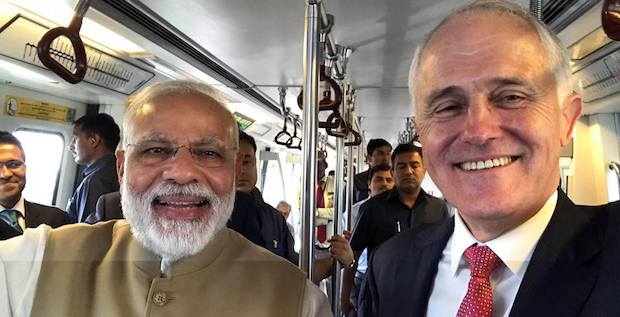Turnbull Talks Trade, Energy and Education with India’s Rock Star Prime Minister

Prime Minister Malcolm Turnbull travelled to India this week to discuss a number of priority issues including trade, energy and education. He met his Indian counterpart, Narendra Modi, riding high on a wave of ‘saffron’ popularity following recent successes in state elections.
Australian Prime Minister Malcolm Turnbull arrived in India on Sunday 9 April for a four-day visit to discuss trade, energy and education. Of course, the visit also required making vague statements about our countries’ mutual love of a certain quintessentially British sport and a certain quintessentially Athenian system of government. Cricket and democracy dispensed with in his press statement, Turnbull and Indian Prime Minister Narendra Modi proceeded to sign a flurry of agreements—one calling to significantly expand counterterrorism cooperation—before snapping some selfies on New Delhi’s metro.
While Turnbull may be struggling to gain traction in the Australian opinion polls, his ‘rock star’ Indian counterpart is riding high on a wave of popularity after securing victory for his Bharatiya Janata Party (BJP) in a series of state elections held earlier this year.
In February, I wrote for Australian Outlook that Modi’s success or failure in India’s 2019 general election hinged on his Party’s success in a suite of state elections being held in March this year. The most significant of these elections was in the state of Uttar Pradesh, home to a staggeringly large population of approximately 200 million people. Polls in Uttar Pradesh are typically a bellwether of national general election results, and the BJP needed to win there to have any hope of increasing power in the Rajya Sabha (India’s upper house), something it badly needed to do if it had any hope of passing critical legislation prior to the 2019 general election. The state is also crucial to determining the outcome of upcoming presidential elections.
As it turned out, the BJP won a remarkable 325 seats out of a total of 403—the largest majority for any party in Uttar Pradesh since 1980. Most exit polls had the BJP well-placed, predicting a win of approximately 200 seats but falling short of a simple majority. The final results have, however, been hailed as a ‘saffron wave’ in much the same way as the 2014 general election, which saw the BJP sweep to power at the national level.
The victory has enlivened BJP politicians across India. The Chief Minister of the Indian state of Madhya Pradesh, Shivraj Singh Chouhan, called the victory a “Modi Storm”, during which “the opposition alliance was blown away like straw”. He praised Modi’s personal qualities, noting that the poor of India saw him as their “Messiah”. Modi himself told his 128 million Twitter followers that the outcome was a “victory for development and good governance”. Jubilant celebrations outside the BJP headquarters in New Delhi and in Lucknow (the capital of Uttar Pradesh) continued for days, coinciding with the colourful Hindu festival of Holi.
The explicitly Hindu nationalist BJP won even Muslim-dominated areas despite not running a single Muslim candidate, including in Muzzaffarnagar where more than 60 people were killed during Hindu-Muslim violence in 2013. This result challenges some long-held Indian political truisms: for example, that Muslims vote as a cohesive group, or ‘vote bank’, and that they do not vote for the BJP.
Exactly why Muslim voters should choose to support Hindu nationalist candidates remains to be fully understood but there are a number of possible theories, the most obvious being that Modi has successfully projected himself as a champion of the poor. Other, more subtle but not necessarily more accurate, analyses might point to the insecurities of Muslim voters in minority Muslim areas. Regardless, the reasons behind the result seem of little interest to the BJP, the party is certainly not making any effort to woo the Muslim electorate.
In fact, in Uttar Pradesh at least, the BJP is pushing a concertedly Hindu nationalist—or Hindutva —agenda. The clearest indication of this has been the party’s choice of chief minister, Yogi Adityanath, a pro-Hindutva, anti-Muslim firebrand and Hindu priest. Adityanath is no stranger to politics, having been a member of parliament in Uttar Pradesh for five consecutive terms since 1998. He also founded the militant Hindutva youth group, the Hindu Yuva Vahini, famous for occasional anti-Muslim rioting, arson and some murders. During his tenure as a member of parliament, Adityanath has had a strained relationship with the BJP, accusing it of diluting its Hindutva ideology for political gains. His promotion to chief minister of India’s most populous state sends a very clear message.
The political maneuverings of Adityanath are likely of no interest to Turnbull, however, and nor should they be. His first official visit to India has been a red carpet affair, with a ceremonial welcome, an inspection of India’s defence forces and a wreath-laying ceremony at New Delhi’s Mahatma Gandhi memorial.
Turnbull’s visit to India has been more cautious than his predecessor, Tony Abbott’s, whose pet project free trade agreement he largely quashed with a tellingly downbeat statement: “It is a process that will take some time.” Abbott had tried to push the deal for a Comprehensive Economic Cooperation Agreement between India and Australia through in just 12 months but negotiations have stalled since he left office. While trade should rightly be a priority issue for the both leaders, Turnbull has sought to redirect attention to the energy and education sectors.
Indian students contribute nearly $2.5 billion to the Australian economy through tertiary and vocational education, second only to China, and their numbers are growing. For Australia, the international education sector is clearly important but it may well be even more so for India. The country has a young population—the 2011 census showed that around 41 per cent of India is under the age of 20—and Modi knows he must manage the situation carefully if India is to benefit, rather than suffer, from this ‘youth bulge’. Education and training are central to the Indian prime minister’s plan to make his country into what some have called a “human resource superpower” and Turnbull, with Minister for Education Simon Birmingham by his side, reiterated that Australia is here to help.
Australia is also, apparently, keen to help India keep the lights on. Turnbull would like to do this with coal. This is despite India’s declining coal imports and increasing uptake of renewable energy; the Indian economy could be coal-free by 2050 according to research from New Delhi-based think tank the Energy and Resources Institute. On Monday evening the Australian prime minister met with senior executives of the Adani Group, including Founder and Chairman Gautam Adani, to discuss the company’s $21.7 billion Carmichael coal project. The project has faced serious opposition from environmental and indigenous groups, but Turnbull reportedly told Adani that a recent Federal Court decision on native title would not threaten the giant coal mine.
As Turnbull concludes his visit to India with a racing, business-focused trip to Mumbai, he will hopefully take away with him a little more enthusiasm for India. He might also hope to take away a little of Modi’s popularity. Ultimately, though, Australia’s relationship with India must continue to grow and develop in line with increasing people-to-people ties between the two countries. There is more here than cricket and democracy.
Dr Kimberley Layton holds a PhD in international studies from the University of New South Wales, where her research focused on Hindu nationalism in the Indian Diaspora. She is also a former AIIA Euan Crone Asian Awareness Scholarship holder.
This article is published under a Creative Commons Licence and may be republished with attribution.




